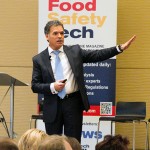Research and development (R&D) is an essential starting point toward the creation or modification of new and exciting food products, processes and packaging. To ensure that a product is safe for consumption, food safety should be considered during the initial stages of a product’s lifecycle. Incorporating food safety into R&D can be tricky, as safety considerations may change the initial idea or concept of a new food product. For example, the idea of a freshly squeezed orange juice in every supermarket shelf is appealing; however, without pasteurization, that juice will not be safe for consumption, nor will it have the desired shelf life. Adding raw chopped garlic to a hummus product makes it taste great, but will it be safe for consumption after being on the shelf for a month?
To better understand how safety of new products is assured from concept to launch, I spoke with two R&D scientists about food safety considerations during new product development. The interviewees, Maria and Laura, work for the same large food manufacturer, which is located in the Midwest, in the snack foods and breakfast cereals categories, respectively. They both confirm that the R&D team follows a specific procedure during the product concept phase—one that places food safety at the forefront. The team starts by determining how the new product compares to food safety regimens already in place with other products that the company manufactures. If the product is a line extension with only a few changes to an existing formulation, the food safety concerns are likely to be low, and the food safety program already in place is adapted to meet the safety needs of the new product. However, if the product being developed is highly differentiated from other products manufactured by the company, food safety moves into a more central role throughout the development cycle.
According to Maria and Laura, the first step in ensuring food safety for a new product is for the development scientists to have in-depth discussions about the product’s formulation, ingredients and supply sources. These three aspects, along with the planned manufacturing process, are then evaluated through a hazard assessment. The hazard assessment is comprised of microbiological, quality, regulatory, stability and physical hazard assessments. Ingredients that pose food safety concerns without prior controls and process conditions are identified. The quality team determines controls for these ingredients and subsequently involves process engineers to verify that process conditions are attainable and will provide proper control for the hazards identified. A complete HAACP plan is put in place for the new product production, taking into consideration equipment cleanability and location, traffic control for ingredients and operators, and air handling systems. The hazard assessment is documented in detail and must be approved by the quality manager before production runs can begin and development can resume. Although the entire process is led by R&D, multiple other functions are involved and consulted throughout the process.
Manufacturing processes, formulation and market availability of ingredients drive the food safety of a new product, with manufacturing processes and formulation usually being the key drivers. “However, in cases like the recent shortage of eggs due to the avian flu crisis, finding substitutions for ingredients in shortage becomes an important driver for food safety,” says Maria. Laura says that at times, product formulations can change due the integrity of the ingredient or its source. In such cases, a similar ingredient from a credible source is chosen and the safety of the product is re-assessed. There are critical quality and food safety elements that must be considered in the product design phase to prevent issues later in development. When R&D professionals keep these elements top-of-mind when considering formulation and ingredient sourcing, everyone benefits—from the company to consumers.
Although consumer confidence in the safety of the U.S. food supply is slipping (11% said they were “very confident” in the safety of the food supply, down from 15% in 2013; 50% said they were “somewhat confident”, down from 55% in 2013, according to the International Food Information Council’s 2015 Food and Health Survey), the interview with Maria and Laura shows that manufacturers are putting significant effort into developing safe food products. It is equally as important for suppliers and vendors to have robust food safety programs to build strong relationships with manufacturers. Food companies have a lot to lose if a product they develop is, or becomes, unsafe for consumption. Not only can the average cost of a recall add up to $10 million in direct costs to a food company, lost sales and the impact to the company’s market value, brand reputation, and business relationships is major. Some companies never recover from the punch. Through taking the time to audit suppliers, screen new ingredients, and make robust prototypes, food companies can be more confident in the safety of their innovative new products as they go through the development process.








Very helpful and Great information,
we appreciate advise especially coming from a professional.
Thanks again and keep up the great work!
Read more at http://vibrantwave.com